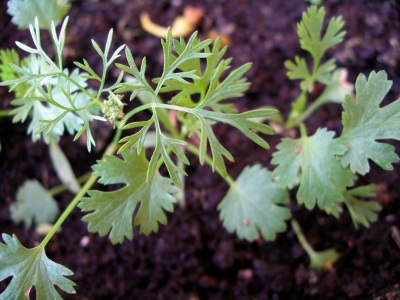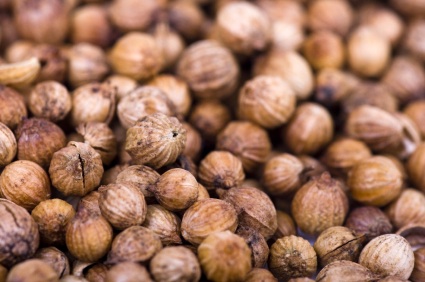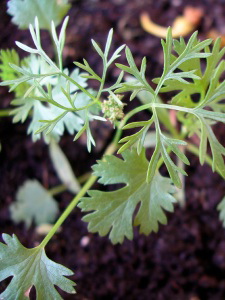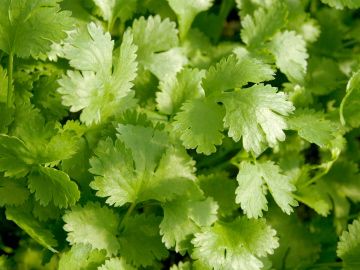
feature-image, l
(article, Sona Pai)
Describing the way something tastes often means comparing it to something else. Fennel tastes like licorice. Parmesan has a nutty flavor. Frog legs, alligator, and rattlesnake taste like chicken. But when we come across a food with a flavor we find unique, our best attempts at descriptive precision require some creative imprecision. Take cilantro, an herb that people seem to either love, hate, or love to hate. Personally, I love it. Growing up in an Indian household, I ate cilantro just about every day: sprinkled on my mother’s turmeric-yellow cauliflower, mixed in with my dad’s chicken curry, and puréed with mint in the spicy green chutney we ate with samosas or spread on a slice of bread. I don’t remember ever thinking much about cilantro, just that it was always there and that it made everything taste sort of brisk and bright and green. I know that, technically, none of those words refers to a taste, but they are the best I can do. When I began cooking on my own, I was surprised to find that some of my friends didn’t like cilantro. More accurately, they were revolted by it. Just saying the word "cilantro" made their faces contort in ways that actually looked painful. They said they couldn’t stand it, not even a little whiff of it. They said it tasted like fertilizer or cat litter or old pennies. The most common complaint was that it tasted like soap. [%image "curry" float="left" caption="A cilantro garnish on chicken curry." credit="Photo: iStockphoto/isatori"] I assumed these people were just picky eaters and bad sports. They just weren’t used to cilantro, and so they assumed they didn’t like it without really giving it a fair shot. But the bizarre descriptions kept coming. I’ve heard people say it tastes like aluminum foil and like air freshener and like a migraine. Jed Sundwall, who works at an Internet startup in San Diego, has been filming a documentary about cilantro as a side project. So far, he’s filmed people in Mexico, Brazil, Malta, San Diego, New York City, and Washington, D.C., talking about how they feel about cilantro, and he’s heard plenty of badmouthing. One woman who had moved to northern Brazil from the south told him she lost 17 pounds because she couldn’t eat the north’s cilantro-laden food. “I’ve also heard someone say it tastes like hitting yourself in the head,” Sundwall says. Sundwall says two of the most interesting things he’s learned about cilantro to date are: 1. It’s thought to be the most widely used herb in the world. 2. Julia Child hated it. In a 2002 interview, Child told Larry King that the two foods she didn’t like at all were cilantro and arugula. She said if she saw one of them on her plate, she’d pick it out and throw it on the floor. To her, they had a “dead taste.” h3. An ancient plant For just about anyone who grew up in the diverse culinary traditions of Latin America, the Caribbean, Portugal, northern Africa, the Middle East, the South Asian subcontinent, and most of Asia, cilantro tastes like home. The plant, Coriandrum sativum, is rich in vitamins A and C and belongs to the same family as carrots, cumin, anise, parsley, caraway, dill, and less common herbs with cool names like centella, sweet cicely and rock samphire. Archaeological and linguistic evidence indicate that the plant, likely a Mediterranean native, was widely cultivated throughout that region, the Middle East, and South Asia by the second millennium B.C. and possibly even earlier. Today, the term “cilantro” refers to the plant’s delicate green leaves, while the seeds, which are technically fruits, are known as coriander. A beloved spice in the cilantro-loving world, coriander was also common in medieval Europe, and it’s still used throughout Europe as a flavoring for baked goods, sweets, beer, gin, and pickles. Coriander has a strong, floral flavor, but it doesn’t share cilantro’s bad reputation. Even people who hate cilantro don’t seem to have a problem with coriander. When I gave my cilantro-hating friend Jason a coriander seed to chew on, he was fine with it, but he had to spit out a cilantro leaf immediately. My friend Yasmin says coriander is one of her favorite spices, but she says cilantro tastes like “pungent grass that may have been urinated upon.” [%image "coriander" float="right" caption="Coriander seeds." credit="Photo: iStockphoto/jaroon"] Food writers and cilantro haters often repeat the assertion that the original Greek name of the plant, koriannon, is derived from the Greek word for bug, koris. More specifically, they say it’s a reference to the bedbug, which emits a musty, unpleasantly sweet odor when crushed. In the spring 2001 issue of Gastronomica magazine, Helen Leach argues that there is no direct evidence to suggest a linguistic connection. She found ancient Greeks and Romans who wrote about coriander and about bedbugs, but she didn’t find anyone comparing the two or the way they smelled. Still, the stinky etymology stuck. In America and Europe, the use of the Spanish term "cilantro" and the euphemism "Chinese parsley" may be part of an attempt to ease the Western palate into accepting the herb by separating it from the odious odor of its past. h3. Is it all in the genes? Although references to bedbugs persist, the trash talk you’re more likely to hear today is about that soapy taste. There’s also a rumor going around, among haters and in print, that people who hate cilantro actually have a genetic aversion to it, although no definitive studies exist. Charles J. Wysocki, an olfactory scientist at the Monell Chemical Senses Center in Philadelphia, studies individual variations in people’s perception of odors. He’s most interested in the way differences in age, sex, experience, heredity, and knowledge affect olfactory perception, which is mostly responsible for what we call taste. For example, when given a sample of butyric acid, some people will say it smells like a strong-flavored cheese, and others will say it smells like sweaty feet. Both are correct; the acid occurs naturally in aged cheeses and human perspiration, but the positive or negative associations come from the individuals, not the substance itself. [[block(sidebar). h1. Cilantro to the rescue? Love it or hate it, you may end up consuming a crucial component of cilantro one day without realizing it. Dodecenal, a naturally occurring compound found in cilantro plants, is more effective at killing salmonella than conventional antibiotics. Not that downing a jar of salsa will stave off a salmonella infection if you've just eaten raw chicken, but dodecenal may someday be used to develop medications. ]] In 2003 and 2004, Wysocki tried testing for inherited olfactory similarities by taking samples of different scents, including fresh cilantro, to the annual Twins Days festival in Twinsburg, Ohio. He asked pairs of identical and fraternal twins to smell each smell and then rate it on a scale of pleasantness. “With cilantro, the correlation between identical twins, who share the same genes, was very strong. If one liked it, the other one usually did, too,” Wysocki says. “With fraternal twins, it was like flipping a coin.” These results indicate that our genes have something to do with our taste for cilantro. But they’re just a first step toward determining whether there’s a particular reason for a genetic aversion to the herb. Wysocki suspects that one of two things is happening because of the active or inactive state of a particular olfactory gene: 1. Cilantro haters can detect something unpleasant in cilantro that others can’t taste. 2. Cilantro haters can’t detect something pleasant in cilantro that others can taste. Either way, the difference is likely the result of our individual physiology slowly catching up with our cultural evolution from nose-to-the-ground hunter-gatherers, to agrarian societies, to the end consumers we are today. We don’t need to smell (or taste) as acutely as we once did, so some of our olfactory genes have simply stopped functioning. h3. Cilantro lovers of the world, unite! As of February 2007, the online community IHateCilantro.com had more than 1,200 members around the world, with the highest concentration in America. Although many of them agree that cilantro tastes like soap, they also say it tastes like mildew, dandelions, earwax, doll hair, dirt, baby wipes, rotting meat, and sucking on a dryer vent. [%image "cilantro" float="right" caption="Fresh cilantro growing in a garden bed." credit="Photo: iStockphoto/kajaberry"] In haikus, angry anecdotes, and language that would get them a mouthful of real soap from some mothers, members complain and commiserate about “the devil’s weed.” Some defensive cilantrophiles launched the website ILoveCilantro.com in response, but all you’ll find there are a few lonesome recipes and some requests for participation. While the haters are a little more outspoken and a lot more organized on the World Wide Web, they’re outnumbered in the real world, where I’m betting you won’t find many Latin American, South American, Middle Eastern, South Asian, or East Asian people who think cilantro tastes like soap or burned rubber or shoes. In my own totally unscientific, informal poll of my friends — including a mix of people who had grown up eating cilantro and those who hadn’t — I found five haters, four people who (somehow) didn’t feel strongly about the herb, and 35 lovers. [[block(sidebar). h1.Featured recipe]] The cilantro lovers are just as effusive in their affection as the haters are in their disgust. The people I polled described cilantro’s taste as tangy, fresh, summery, earthy, minty, exotic, clean, alive, smooth, grassy, healthy, and savory. Or like sunshine, peppery lime, spicy citrus, a crisp Brazilian day, and a breeze on a Caribbean shore. In the end, one person’s expensive cheese is just another person’s stinky sock, and someone’s soapy weed is someone else’s favorite herb, brisk and bright and green. p(bio). Sona Pai is a freelance writer and editor based in Portland, Oregon.

feature-image, l

coriander, l

cilantro, l

curry, l

featurette-image, l

reference-image, l